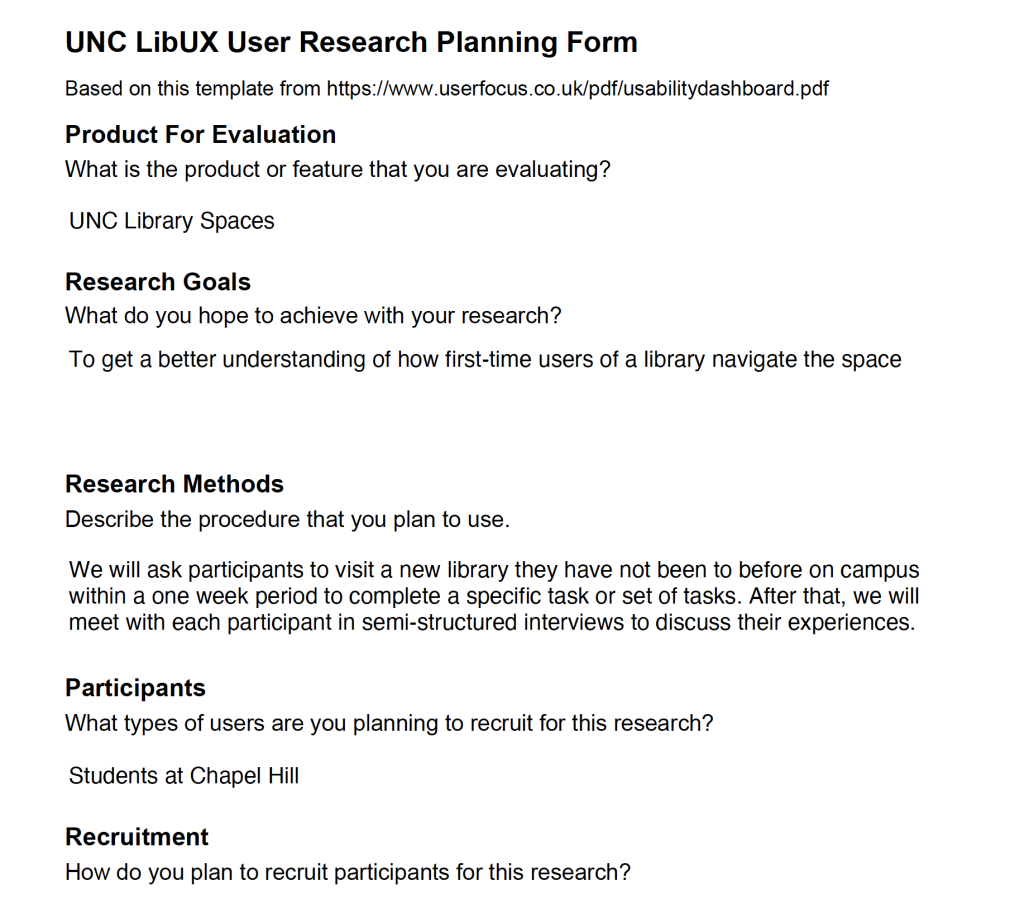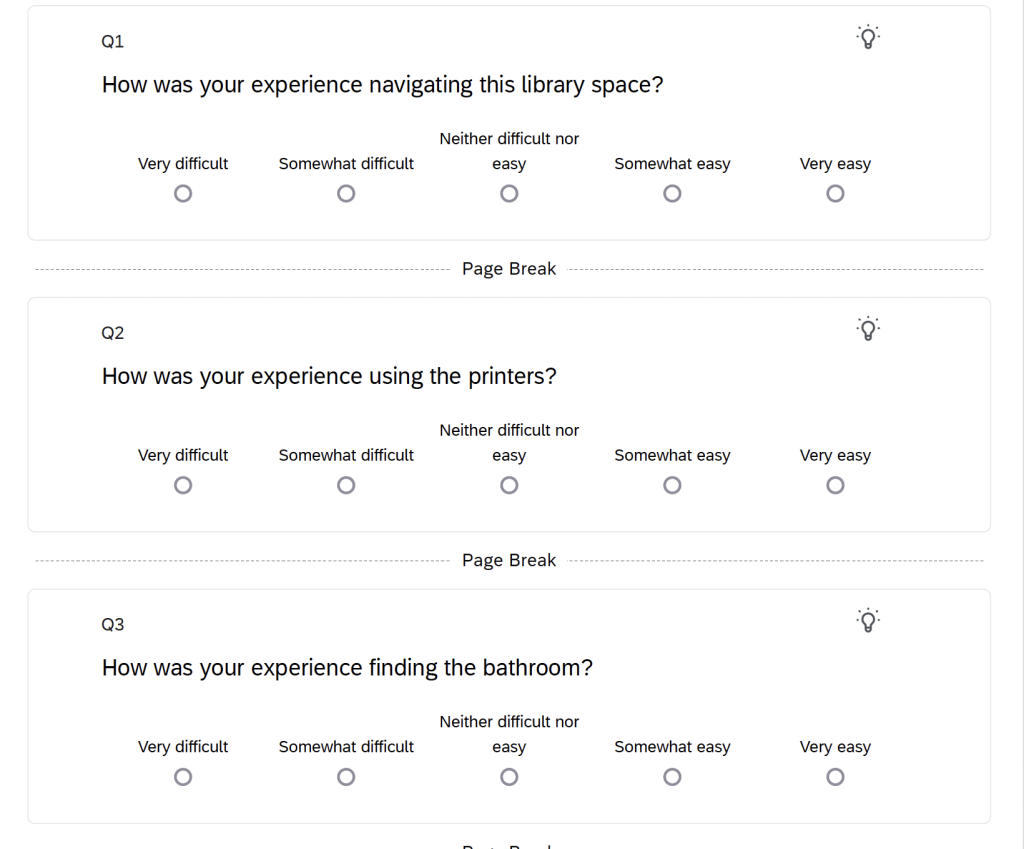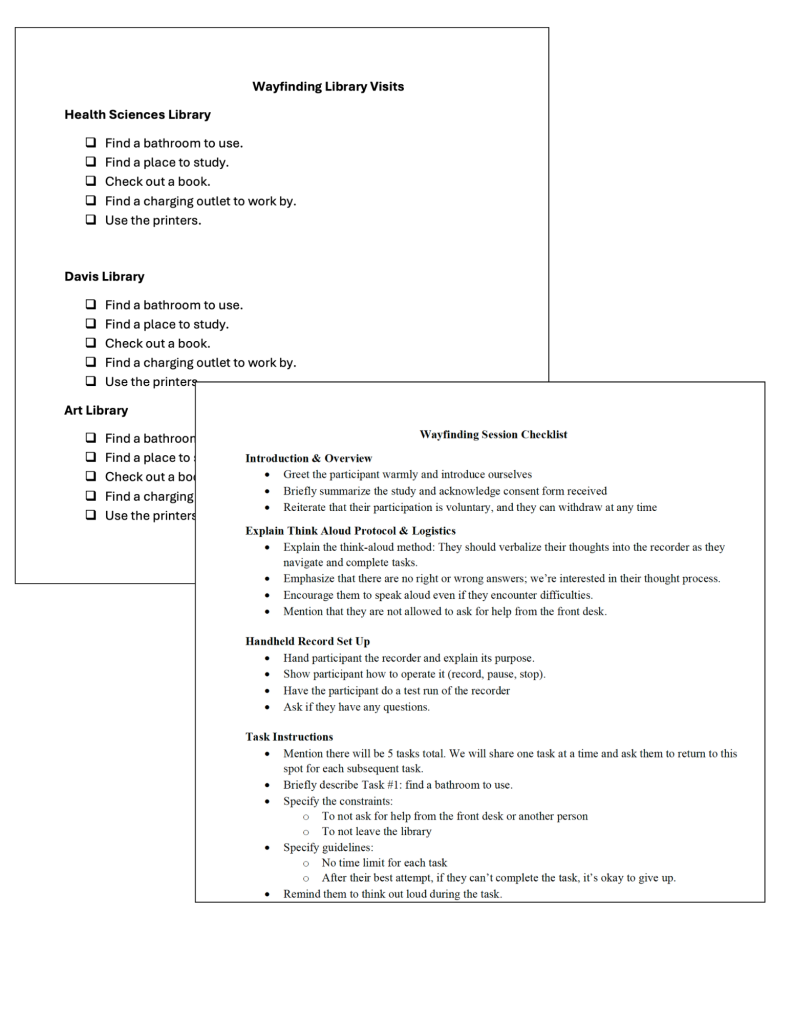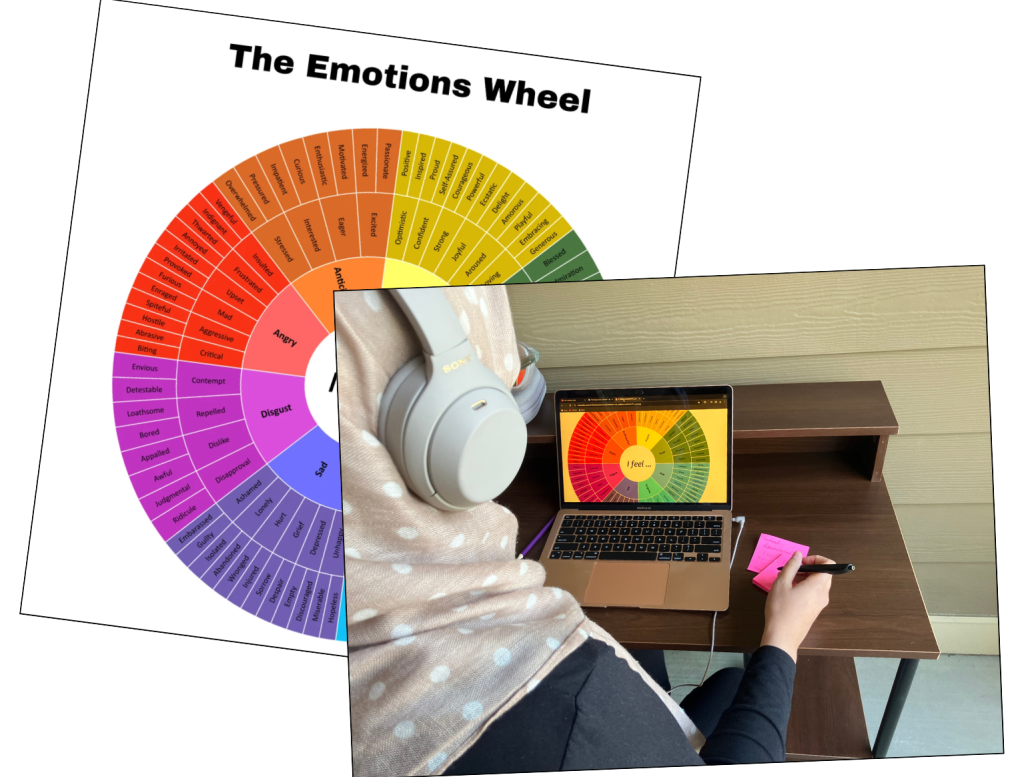Project Summary
I was presented with a research interest in the UX department to conduct a wayfinding study about how first-time users navigate library spaces on UNC’s campus. I set up meetings with our user research team lead to discuss methodology and preparation— bringing new ideas such as using e-signatures for consent forms or conducting an emotions analysis, and creating materials like test scripts and the recruitment survey. Presenting the results to our department garnered excitement and new questions for future offshoot research as the master space planning initiative kicks off for UNC University Libraries.
Research Problem
Problem Statement
Previous user research had shown us the significant of a role that the physical space the University Libraries offered to student played in serving our patrons. For this research, I sought to understand how users navigated the library spaces— that is, I was interested in exploratory research on users thought processes, beliefs and attitudes on wayfinding in a library space they visited for the first time.
My Role & Team

Principal Researcher
I worked as the Research Assistant on the UX team in the libraries and worked closely with the User Experience Research and Design Librarian
Research Methodology

Research Method- Task Analysis
Our Goal: I worked collaboratively with the User Research & Design Librarian to develop our process. This research was qualitative in nature, and my goal was to better understand how users think about a library space when navigating it.
Coming up with tasks: I came up with a list of common tasks that our users— mostly students— often perform in library spaces. In collaboration with my teammate, I narrowed the list to 5 tasks to have participants complete in the library. Participants would use a voice recorder to record their thoughts while completing the tasks.
Research Method- Debriefing Session
Choosing an Evaluation Scale: I researched different evaluative user research scales and recommended we use the SEQ (Single Ease Question) scale for two reasons:
1) Limit Biases
Likert scales can be limited by social desirability bias, especially since we would conduct post-study debriefing sessions in person with participants
2) Focus on Thoughts
I was interested in participants’ opinions and beliefs and a semantic differential question got closer to that than an agree/disagree scale.


Participant Recruitment & Consent
To mitigate for already having explored a space, I only recruited users who had never visited one of our campus library branches before. I prepared the participant recruitment survey questions using Qualtrics.
Introduction calls: I held intro calls with each participant to give an overview of the study, obtain consent, and schedule a time to conduct the study with them during a one week period of March 18-22, and to obtain consent. I wrote the consent form, and when we pivoted from in-person to Zoom calls at last minute’s notice, I quickly converted the consent form process to a digital form that allowed for e-signatures through Qualtrics. I did this to make the consent form collection process easy with minimal email attachments back-and-forth.

Expanding Our Incentives
In wanting to be as inclusive as possible in our recruitment process, I suggested the idea of offering a range of gift card options and listing those incentives on the flyer to minimize unintentional recruitment bias (for example, research suggests Amazon is most frequently used by those who are more well off). I believe small and subtle changes like these in the UX process can naturally deliver better products.
Prepping- Scripts & Materials
Equipment Testing: My teammate took leadership on scheduling a test session of the voice recorder equipment. I made it a point to attend with him because I thought it was important to understand how the equipment works as I would also be conducting the sessions, and I thought it was good to build team spirit with my co-researcher.
Library Visits: I developed a checklist and toured all of the library spaces to ensure that all of the tasks were able to be accomplished in each library space. This raised new questions that allowed us to iron out some fine details of the study— for example, students would not actually have to print an item since it would cost them print money, and students would indeed go through actually checking out a book.
Day-Of Materials: I wrote the checklist and the debriefing study script to use on the day of the user research. It really helped to have a checklist of items to cover when meeting with the participant, such as making sure to do a test run with the equipment and stating the guidelines.


Research Analysis— Emotions Coding
With a background in storytelling, I knew that emotions are an extremely important but often forgotten or more difficult aspect of user research to capture. I brought this up for discussion with my colleague— we decided that he would code the audio transcripts while I would code the emotions by listening to the audio only. This work was done in Dovetail.
I grounded this analysis in Plutchik’s theory of emotions. To be able to focus exclusively on the emotions present in how participants’ were speaking, I conducted “blind” listening of the audio recordings, meaning I did not look at the transcripts as I listened. To keep the range of emotions front and center in my mind, I also kept an image of an Emotions Wheel based off Plutchik’s theory in front of me as I listened, alongside a sticky notes pad to jot done notes.
Research Deliverables & Results
User Research Report
My colleague and I worked on the final report together in Notion and presented our findings to the UX team. We met to discuss our results and findings, and I took lead on the emotions analysis. Using Plutchik’s theory, I grouped all of the emotions into their respective 8 umbrella categories ranging from anger to trust and wrote up findings based on thematic patterns that emerged from the most common emotions present.
In addition to learning how users rely heavily on signage, social cues and past experiences with other libraries to wayfinding, the emotional analysis enriched our results by being able to think about how users feel uncertain when signage is missing or a sense of delight when able to find new or unexpected study spaces. Our findings, especially the emotions piece, excited the team and opened up new avenues to better understand our users’ experiences with UNC libraries.

Research Retrospective
This was a first of its kind user research study for our team, and I enjoyed working closely with a colleague with whom I could bounce around ideas. If I could go back, I would see about building in team capacity to have other members also code the recordings, so there is more input and perspective on that part of the analysis— especially for the emotions analysis which was challenging and a subjective call made by me.
Attributions
- Hijabi female icon: Hijab icons created by Freepik – Flaticon
- Lightbulb icon: Creative thinking icons created by Freepik – Flaticon
